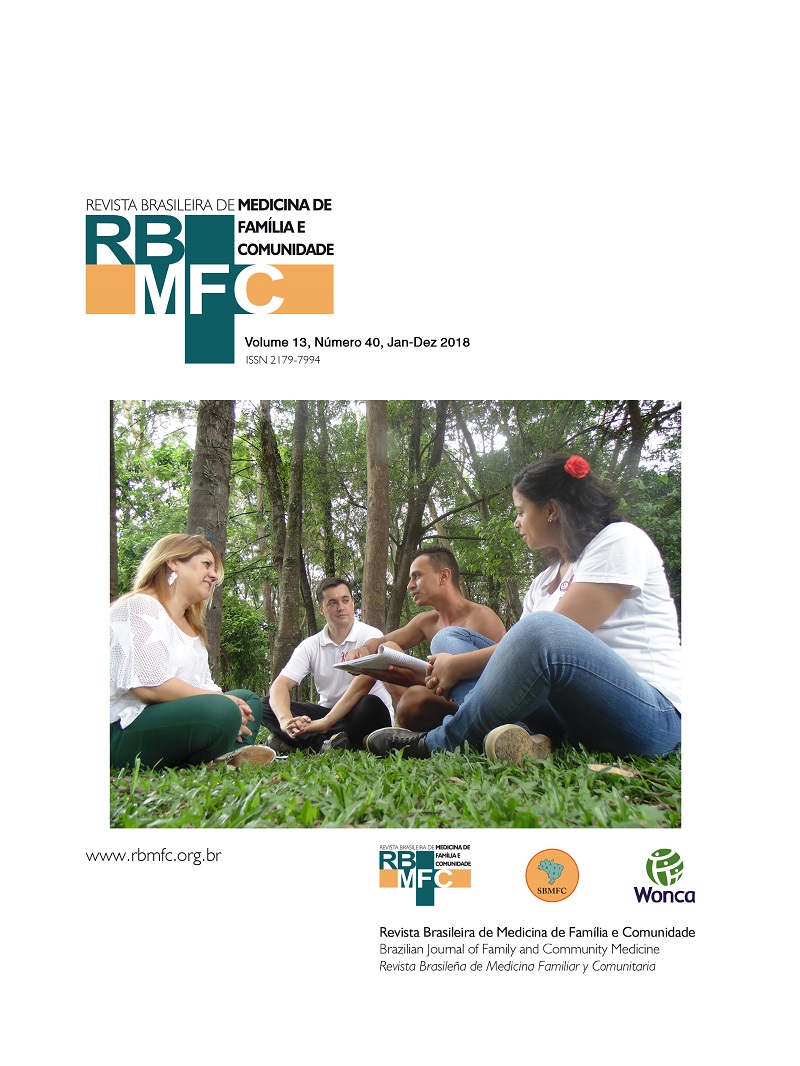Implicaciones éticas, pedagógicas, sociopolíticas y antropológicas de la prevención cuaternaria
DOI:
https://doi.org/10.5712/rbmfc13(40)1860Palabras clave:
Prevención Cuaternaria, Ética Profesional, Medicina Basada en la Evidencia, Medicina GeneralResumen
El concepto de prevención cuaternaria, resultante de una reflexión sobre la relación médico-paciente, se presenta como una renovación del antiguo requisito ético: primero, un médico no debe hacer daño; segundo, el médico debe controlarse a sí mismo. El origen del concepto, su respaldo por parte de la Organización Mundial de Médicos de Familia (WONCA) y la Unión Europea de Médicos Generales (UEMO), su difusión, y los debates a los que ha dado lugar, son presentados por un panel de autores de 10 países. Este texto colectivo trata más específicamente de: la bioética de la prevención, la importancia de la enseñanza de la prevención cuaternaria y la medicina práctica, las implicaciones sociales y políticas del concepto de prevención cuaternaria y sus dimensiones antropológicas.
Descargas
Métricas
Citas
Lévy E. Ilya Prigogine «L’incertitude, c’est la vie»: lepoint.fr; 2002/01/18 [Available from: http://www.lepoint.fr/actualites-chroniques/2007-01-20/ilya-prigogine-l-incertitude-c-est-la-vie/989/0/60025.
Bloy G. L’incertitude en médecine générale: sources, formes et accommodements possibles. Sciences sociales et santé. 2008;26(1):67-91.
Davidoff F, Haynes B, Sackett D, Smith R. Evidence based medicine. BMJ. 1995. DOI: https://doi.org/10.1136/bmj.310.6987.1085
Greenhalgh T, Howick J, Maskrey N. Evidence based medicine: a movement in crisis? Bmj. 2014;348:g3725. DOI: https://doi.org/10.1136/bmj.g3725
Clark EG. Natural history of syphilis and levels of prevention. British Journal of Venereal Diseases. 1954;30(4):191. DOI: https://doi.org/10.1136/sti.30.4.191
Bury J. Éducation pour la santé: concepts enjeux planifications. 1988.
Gofrit ON, Shemer J, Leibovici D, Modan B, Shapira SC. Quarternary prevention: a new look at an old challenge. Isr Med Assoc J. 2000;2:498-500.
Bentzen N. WONCA Dictionary of General/Family Practice. Copenhagen: Maanedsskr; 2003.
Jamoulle M. Information et informatisation en médecine générale [Computer and computerisation in general practice]. Namur, Belgium: Presses Universitaires de Namur; 1986.
Jamoulle M. Quaternary prevention, an answer of family doctors to overmedicalization. Int J Health Policy Manag. 2015;4(2):61-4. DOI: https://doi.org/10.15171/ijhpm.2015.24
Hellstrom OW. Health promotion in general practice. Eur J Public Health. 1994;4:119-24. DOI: https://doi.org/10.1093/eurpub/4.2.119
Sadegh-Zadeh K. Anamnesis and diagnosis. In: Sadegh-Zadeh K, editor. Handbook of Analytic Philosophy of Medicine. Dordrecht: Springer; 2015. p. 363. DOI: https://doi.org/10.1007/978-94-017-9579-1
Carpentier J. Medical Flipper. Cahiers libres, 402. 1989:154.
UEMO. UEMO position on Disease Mongering/Quaternary Prevention 2008 [Available from: http://www.uemo.eu/2011/02/08/uemo-position-on-disease-mongering-quaternary-prevention/
Jamoulle M, Tsoi G, Heath I, Mangin D, Pezeshki M, Pizzanelli Báez M, editors. Quaternary prevention, addressing the limits of medical practice. WONCA World; 2013 2013; Prague.
Foucault M. La crisis de la medicina o la crisis de la antimedicina. 1974. Revista Cubana de Salud Pública. 2018;44:172-83.
Brownlee S. Overtreated: Why too much medicine is making us sicker and poorer: Bloomsbury New York; 2007.
Martins C, Godycki-Cwirko M, Heleno B, Brodersen J. Quaternary prevention: reviewing the concept: Quaternary prevention aims to protect patients from medical harm. European Journal of General Practice. 2018;24(1):106-11. DOI: https://doi.org/10.1080/13814788.2017.1422177
Sagan A, Panteli D, Borkowski W, Dmowski M, Domanski F, Czyzewski M, et al. Poland health system review. Health Systems in Transition. 2011;13(8):1-193.
Godycki-Ćwirko M, Krawczyk J, Tomiak E, Osiecka R, Mazurek L, Ludwikow G, et al. Czasochłonność profilaktyki w podstawowej opiece zdrowotnej [Time requirements for prevention in primary health care]. Probl Med Rodz. 2009;1(26):23-7.
Wonca Special Interest Group on Quaternary Prevention and Overmedicalisation. Manifeste; La Prévention quaternaire, présent et futur Proclamation de Rio de Janeiro. Décembre 2016 [Available from: http://www.ph3c.org/PH3C/docs/27/000449/0000842.pdf.
WONCA Special Interest Group: Quaternary Prevention & Overmedicalization 2017 [Available from: http://www.globalfamilydoctor.com/groups/SpecialInterestGroups/QuaternaryPrevention.aspx.
Gomes LF, Gusso G, Jamoulle M. Teaching and learning quaternary prevention. Revista Brasileira de Medicina de Família e Comunidade. 2015;10(35):1-14. DOI: https://doi.org/10.5712/rbmfc10(35)1050
Alber K, Kuehlein T, Schedlbauer A, Schaffer S. Medical overuse and quaternary prevention in primary care–A qualitative study with general practitioners. BMC family practice. 2017;18(1):99. DOI: https://doi.org/10.1186/s12875-017-0667-4
Franken G. Prävention und Demenz Eine Begriffsklärung Literaturstudie. Witten: Universität Witten/ Herdecke (Arbeitspapier des DZD, 12). Dialog- und Transferzentrum Demenz (DZD); 2016.
La Valle RA. Prevención Cuaternaria o la Medicina sin corbata. Archivos de Medicina Familiar y General. 2015;12:5-6.
Brodersen J, Schwartz LM, Woloshin S. Overdiagnosis: how cancer screening can turn indolent pathology into illness. Apmis. 2014;122(8):683-9. DOI: https://doi.org/10.1111/apm.12278
Martínez CG, Riaño IG, Sánchez MJ, de Dios González J, editors. Quaternary prevention: Containment as an ethical necessity. Anales de pediatria (Barcelona, Spain: 2003); 2014.
Tesser CD. Why is quaternary prevention important in prevention? Revista de saude publica. 2017;51:116. DOI: https://doi.org/10.11606/S1518-8787.2017051000041
Department of Health E. The Belmont Report. Ethical principles and guidelines for the protection of human subjects of research. The Journal of the American College of Dentists. 2014;81(3):4.
Gillon R. Medical ethics: four principles plus attention to scope. BMJ: British Medical Journal. 1994;309(6948):184. DOI: https://doi.org/10.1136/bmj.309.6948.184
Bae J-M. Shared decision making: relevant concepts and facilitating strategies. Epidemiology and health. 2017;39. DOI: https://doi.org/10.4178/epih.e2017048
Smith CM. Origin and uses of primum non nocere—above all, do no harm! The Journal of Clinical Pharmacology. 2005;45(4):371-7. DOI: https://doi.org/10.1177/0091270004273680
Visentin G. The difficult choice of” not doing”: comment on” Quaternary prevention, an answer of family doctors to overmedicalization”. International journal of health policy and management. 2015;4(8):559. DOI: https://doi.org/10.15171/ijhpm.2015.108
Bae J-M, Jamoulle M. Primary care physicians’ action plans for responding to results of screening tests based on the concept of quaternary prevention. Journal of Preventive Medicine and Public Health. 2016;49(6):343. DOI: https://doi.org/10.3961/jpmph.16.059
Gérvas J, Starfield B, Heath I. Is clinical prevention better than cure? The Lancet. 2008;372(9654):1997-9. DOI: https://doi.org/10.1016/S0140-6736(08)61843-7
Deyo RA. Cascade effects of medical technology. Annual review of public health. 2002;23(1):23-44. DOI: https://doi.org/10.1146/annurev.publhealth.23.092101.134534
Medicine AFABoI. ACP-ASIM Foundation. American College of Physicians-American Society of Internal Medicine; European Federation of Internal Medicine. Medical professionalism in the new millennium: a physician charter. Ann Intern Med. 2002;136(3):243-6. DOI: https://doi.org/10.7326/0003-4819-136-3-200202050-00012
Bae J-M. Suggestions for the promotion of evidence-based public health in South Korea. Epidemiology and health. 2017;39. DOI: https://doi.org/10.4178/epih.e2017030
Sackett DL. Evidence-based Medicine How to practice and teach EBM: WB Saunders Company; 1997.
Bae J-M. Value-based medicine: concepts and application. Epidemiology and health. 2015;37. DOI: https://doi.org/10.4178/epih/e2015014
Brown GC, Brown MM, Sharma S. Health care economic analyses. Retina. 2004;24(1):139-46. DOI: https://doi.org/10.1097/00006982-200402000-00019
Jamoulle M. A Comment on “Quaternary Prevention in Public Health” by Dr. Jong-Myon Bae. J Prev Med Public Health. 2016;49(2):139-40. DOI: https://doi.org/10.3961/jpmph.16.031
Charles C, Gafni A, Whelan T. Shared decision-making in the medical encounter: what does it mean?(or it takes at least two to tango). Social science & medicine. 1997;44(5):681-92. DOI: https://doi.org/10.1016/S0277-9536(96)00221-3
Widmer D. Care and do not harm: Possible misunderstandings with quaternary prevention (P4): comment on “Quaternary prevention, an answer of family doctors to over medicalization”. International journal of health policy and management. 2015;4(8):561. DOI: https://doi.org/10.15171/ijhpm.2015.99
Premji K, Upshur R, Légaré F, Pottie K. Future of family medicine: Role of patient-centred care and evidence-based medicine. Canadian Family Physician. 2014;60(5):409-12.
Malin JL. Wrestling with the high price of cancer care: should we control costs by individuals’ ability to pay or society’s willingness to pay?: American Society of Clinical Oncology; 2010. DOI: https://doi.org/10.1200/JCO.2010.28.9967
Swanson JW, Van McCrary S. Medical futility decisions and physicians’ legal defensiveness: the impact of anticipated conflict on thresholds for end-of-life treatment. Social Science & Medicine. 1996;42(1):125-32. DOI: https://doi.org/10.1016/0277-9536(95)00082-8
Bae J-M. Development and application of patient decision aids. Epidemiology and health. 2015;37. DOI: https://doi.org/10.4178/epih/e2015018
Bae J-M. Strategies for Appropriate Patient-centered Care to Decrease the Nationwide Cost of Cancers in Korea. Journal of Preventive Medicine and Public Health. 2017;50(4):217. DOI: https://doi.org/10.3961/jpmph.17.069
Starfield B, Hyde J, Gérvas J, Heath I. The concept of prevention: a good idea gone astray? Journal of Epidemiology & Community Health. 2008;62(7):580-3. DOI: https://doi.org/10.1136/jech.2007.071027
Kalra S, Baruah MP, Sahay R. Quaternary prevention in thyroidology. Thyroid Research and Practice. 2014;11(2):43. DOI: https://doi.org/10.4103/0973-0354.129561
Godycki-Ćwirko M, Tomiak E, Wrzeciono B, Lukas W. Zakres profilaktyki w podstawowej opiece zdrowotnej [Scope of prevention in primary care]. Problemy Medycyny Rodzinnej. 2009;11(1):15-22.
Bentaberry M, Bernstein J, Jamoulle M, La Valle R, Mariño MA, Piñero A, et al. Curso Introductorio a la Práctica de la Prevención Cuaternaria (P4) SUMEFAC & FAMFyG 2017 [Available from: http://www.famg.org.ar/archivos/Version-Imprimible-Curso-Introduccion-a-la-Practica-de-la%20-Prevencion-Cuaternaria%20(P4).pdf.
Tran THV, Vo TL. Impact of quaternary prevention as a brief intervention in medical students’ clinical decisions: experience from Vietnam Impacto da prevenção quaternária como intervenção breve nas decisões clínicas de estudantes de medicina : In the last decades medica. Revista Brasileira de Medicina de Família e Comunidade. 2015;10:1-8. DOI: https://doi.org/10.5712/rbmfc10(35)1119
Hirsch CD, Barlem ELD, Barlem JGT, Dalmolin GdL, Pereira LA, Ferreira AG. Cross-cultural adaptation and validation of the Nursing Student Satisfaction Scale for use with Brazilian nursing students. Revista latino-americana de enfermagem. 2016;24. DOI: https://doi.org/10.1590/1518-8345.1053.2776
Balint M. The doctor, his patient, and the illness. The Lancet. 1955;265(6866):683-8. DOI: https://doi.org/10.1016/S0140-6736(55)91061-8
Illich I. Medical nemesis: The expropriation of health. New York: Pantheon Books; 1976. DOI: https://doi.org/10.1097/00004010-197700000-00017
Engel GL. The need for a new medical model: a challenge for biomedicine. Science. 1977;196(4286):129-36. DOI: https://doi.org/10.1126/science.847460
Commission E. Proposal for a regulation of the European Parliament and of the Councilon health technology assessment and amending Directive 2011/24/EUBrussels: European commission; 31.1.2018.
Sackett DL, Rosenberg WM, Gray JM, Haynes RB, Richardson WS. Evidence based medicine: what it is and what it isn’t. British Medical Journal Publishing Group; 1996. DOI: https://doi.org/10.1136/bmj.312.7023.71
Stange KC, Ferrer RL. The paradox of primary care. Annals of Family Medicine. 2009;7(4):293-9. DOI: https://doi.org/10.1370/afm.1023
Pluye P, Hong QN. Combining the power of stories and the power of numbers: mixed methods research and mixed studies reviews. Annual review of public health. 2014;35. DOI: https://doi.org/10.1146/annurev-publhealth-032013-182440
Olivier de Sardan J-P. La rigueur du qualitatif. Les contraintes empiriques de l’interprétation socio-anthropologique. Lectures, Publications reçues. 2008.
Rossi I. La clínica como espacio social ¿Época de cambios o cambio de época? In: Sutton LHM, Torres A, Hernández I, editors. La comunicación dialógica como competencia médica esencial. Mexico: Editorial El Manual Moderno; 2017. p. 38-57.
Toon P. Books: Mapping Uncertainty in Medicine: What to Do When You Don’t Know What to Do: Mapping the Terrain. British Journal of General Practice; 2016 DOI: https://doi.org/10.3399/bjgp16X687829
Kumar NS. Health situation of scheduled castes in Bolpur-Sriniketan. Anthropological Survey of India. Kolkata: Ministry of Culture; 2011.
Chaudhuri B. Health for All: Looking for an Alternative Approach. Dr Ambedkar Chair in Anthropology. Department of Anthropology, Calcutta University; 2008.
Farmer P, Kim JY, Kleinman A, Basilico M. Reimagining global health: an introduction: Univ of California Press; 2013. DOI: https://doi.org/10.1525/9780520954632
Menendez EL. El modelo médico y la salud de los trabajadores. Salud colectiva. 2005;1:9-32. DOI: https://doi.org/10.18294/sc.2005.1
Descargas
Publicado
Cómo citar
Número
Sección
Licencia
Al enviar un manuscrito al RBMFC, los autores conservan la propiedad de los derechos de autor del artículo y autorizan a RBMFC a publicar ese manuscrito bajo la licencia Creative Commons Attribution 4.0 e identificarse como el vehículo de su publicación original.















